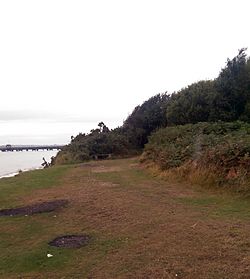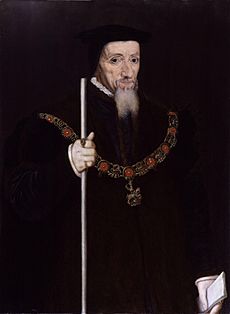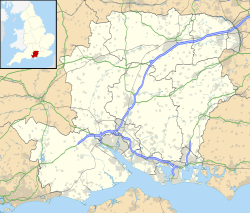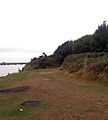St Andrew's Castle, Hamble facts for kids
Quick facts for kids St Andrew's Castle |
|
|---|---|
| Hamble-le-Rice, Hampshire | |

The remains of the castle at high tide
|
|
| Coordinates | 50°51′09″N 1°19′00″W / 50.8524°N 1.3166°W |
| Type | Device Fort |
| Site information | |
| Open to the public |
Yes |
| Condition | Fragments only remain |
| Site history | |
| Built | 1542-43 |
| Materials | Stone |
| Events | English Civil War |
St Andrew's Castle was a special fort built by King Henry VIII between 1542 and 1543. It was located near Hamble-le-Rice, in Hampshire, England. This fort was part of a big plan by the King to protect England from attacks by countries like France and the Holy Roman Empire.
The castle was designed to guard Southampton Water, an important waterway near the Solent. It had a strong tower, called a keep, and a platform for cannons. A moat, which is a deep ditch filled with water, helped protect it. St Andrew's Castle stopped being used in 1642 during the English Civil War. Over time, much of it has been washed away by the sea due to coastal erosion.
Contents
Why King Henry VIII Built Forts
In the 1500s, countries often had disagreements. King Henry VIII of England faced problems with France and the Holy Roman Empire. Usually, local lords and communities were in charge of defending the coast. The King didn't get very involved in building forts.
But things changed in 1533. King Henry VIII wanted to end his marriage to Catherine of Aragon. She was the aunt of Charles V, the powerful ruler of the Holy Roman Empire. The Pope, Pope Paul III, was also upset with Henry.
Because of this, France and the Holy Roman Empire became allies against England in 1538. The Pope even encouraged them to attack England. It looked like an invasion was definitely going to happen.
The Device Programme
To prepare for this danger, King Henry VIII ordered new forts to be built. This plan was called the "Device programme". The forts were placed along the English coastline to defend against any invasion. St Andrew's Castle was one of these important new forts.
Building St Andrew's Castle
St Andrew's Castle was built to protect Southampton Water. This water connects the Solent to the important port city of Southampton. The castle was built right on the shore, in an area now known as Hamble Common. This spot had been used for defense before, even in the Iron Age.
Construction of the castle happened between 1542 and 1543. However, it might not have been fully finished until after King Henry VIII passed away in 1547.
What the Castle Looked Like
The castle had a tall, square keep (a main tower) made of stone. On the side facing the sea, there was a curved platform for cannons. A wide moat, about 25 meters (82 feet) across, surrounded the castle. There was also a wooden breakwater to help protect it from the waves.
The design of St Andrew's Castle was likely similar to another fort built around the same time, West Cowes Castle.
Castle Weapons
A report from 1559 showed that St Andrew's Castle had many weapons. It had different types of cannons, including:
- Two large iron culverins
- A slightly smaller iron demi-culverin
- Two iron sakers
- Two bases
- An iron falcon
- An iron falconet
- A quarter sling
The lighter cannons were probably on the roof of the keep. The two heaviest cannons were placed lower down. The rest of the cannons were on the outdoor gun platform. The castle also had handguns, bows, and other weapons for close-up defense.
Life at the Castle

In 1547, William Paulet became the Keeper and Captain of St Andrew's Castle. He was paid £19 each year for this job. His team, called a garrison, included a master gunner, a porter, and six soldiers. William Paulet was also in charge of Netley Castle, another fort nearby.
By 1559, the number of people working at the castle had become a bit smaller. The garrison then included a captain, two gunners, and four soldiers.
The Castle Today
St Andrew's Castle was still being used in 1623. However, during the English Civil War in 1642, Parliamentary forces decided to stop using it.
The land where the castle stood has been greatly affected by the sea. The shoreline in this area has been moving back by about 0.5 meters (1.6 feet) each year. Because of this coastal erosion, only small parts of the castle's stone walls and earthworks can still be seen today.
The remains of St Andrew's Castle and the land around it are protected by UK law as a scheduled monument. This means they are important historical sites that must be preserved.
Images for kids




